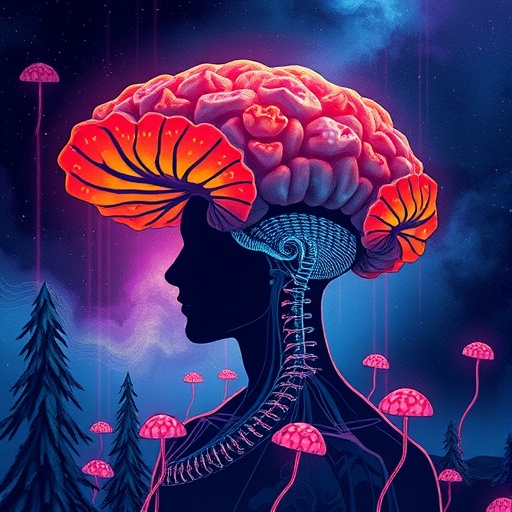In recent years, the resurgence of interest in psychedelic compounds has spurred a wave of scientific investigations into their potential therapeutic benefits. Among these compounds, psilocybin—the psychoactive component found in certain species of mushrooms—has particularly captured the attention of neuroscientists, psychologists, and mental health professionals. A groundbreaking study published in the International Journal of Mental Health and Addiction delves into the nuanced effects of naturalistic psilocybin use on patterns of internalizing problems, substance use behaviors, and cognitive flexibility. Through sophisticated statistical modeling and repeated measures assessments, this research sheds new light on the transformative potential and complex psychological impacts of psilocybin outside controlled clinical trials.
The study by Richard, Scott, Nayak, and colleagues employs a repeated measures latent profile analysis to track psychological and behavioral changes before and after psilocybin ingestion in a naturalistic context. Unlike tightly controlled laboratory settings, naturalistic use allows researchers to observe the compound’s effects amidst the variability of real-world environments. This approach provides a rich and ecologically valid framework for understanding the intricate interplay between internal psychological states and substance use patterns over time. The results reveal a shifting landscape of mental health markers and cognitive functioning that speaks to both the promise and the complexity of psychedelic substances as tools in mental health intervention.
Internalizing problems—a cluster of psychological symptoms including anxiety, depression, and social withdrawal—are notoriously difficult to treat and often resistant to conventional pharmacotherapies. This study meticulously measured these symptoms at baseline and post-psilocybin experience, uncovering that naturalistic use correlates with discernible changes in the severity and presentation of internalizing symptoms. Participants’ profiles shifted in ways that suggest reduced emotional distress and enhanced emotional regulation capabilities. These findings resonate with emerging clinical data from psilocybin-assisted therapy trials, yet significantly contribute by employing a large, naturally occurring sample and sophisticated probabilistic modeling.
.adsslot_U0MV9quPYa{ width:728px !important; height:90px !important; }
@media (max-width:1199px) { .adsslot_U0MV9quPYa{ width:468px !important; height:60px !important; } }
@media (max-width:767px) { .adsslot_U0MV9quPYa{ width:320px !important; height:50px !important; } }
ADVERTISEMENT
Substance use patterns also underwent notable transformations in the timeframe following psilocybin ingestion. The research carefully documented shifts in consumption behaviors across various substance categories, revealing a general trend towards decreased problematic use. Importantly, changes in substance use were not monolithic but nuanced depending on pre-existing user profiles and baseline characteristics. This heterogeneity highlights an essential aspect of psychedelic research: the psychological and behavioral outcomes vary widely among individuals, influenced by factors such as personal history, mindset, and contextual variables surrounding the psychedelic experience.
Cognitive flexibility—a domain central to adaptive thinking and emotional regulation—was a critical focus of this research. Psilocybin’s putative capacity to disrupt rigid cognitive patterns and promote mental plasticity has been theorized to underlie its therapeutic effects. Participants exhibited significant improvements in tasks measuring cognitive flexibility following psilocybin sessions. These enhancements were linked to parallel reductions in internalizing symptom severity, suggesting a neuropsychological mechanism through which psychedelic experiences may facilitate psychological healing. The latent profile analysis also underscored how shifts in cognitive flexibility corresponded to dynamic symptom profiles over time, providing a granular view of the compound’s impact.
One of the study’s key innovations was the application of latent profile analysis (LPA) in a repeated measures design. LPA is a person-centered statistical technique that identifies distinct subgroups within a population based on observed data patterns. By implementing this approach across multiple time points, the authors were able to track individual-level transitions between psychological and behavioral profiles before and after psilocybin use. This methodological sophistication enables a more precise characterization of the heterogeneous responses to psychedelic compounds, moving beyond average group effects to reveal the nuanced trajectories of individual experiences.
The naturalistic setting of the study enhances ecological validity, but also introduces layers of complexity to data interpretation. Unlike randomized controlled trials, where dosing, preparation, and environment are tightly controlled, participants in this research ingested psilocybin in diverse real-world contexts. This variability mirrors the challenges and opportunities of translating psychedelic science into everyday settings. The findings suggest that while psilocybin’s therapeutic potential remains promising, it is profoundly context-dependent. Legal, social, and individual psychological factors dynamically interact to shape outcomes, emphasizing the need for harm reduction frameworks and supportive environments in naturalistic or recreational use.
Neurobiologically, psilocybin acts primarily as a partial agonist at serotonin 5-HT2A receptors, promoting widespread changes in brain network connectivity and neural plasticity. These neurochemical alterations are thought to underpin the observed changes in internalizing symptoms and cognitive flexibility. The study’s behavioral data align with current neuroscientific models by illustrating how shifts in mental health states and cognitive function co-occur following serotonergic modulation. Further integration of neuroimaging and biomarker data could provide complementary insights into the neural substrates of these psychological transitions.
Another dimension worth highlighting is the longitudinal aspect of the study, which monitored participants over an extended timeframe. This temporal scope offers valuable clues about the sustainability and durability of psilocybin’s effects. While immediate post-experience improvements in internalizing symptoms and cognitive function were noted, some shifts persisted weeks or months later, indicating possible long-term reorganization of mental health trajectories. However, variability remains, and not all participants exhibited lasting benefits. This calls for continued research into predictors of positive outcomes and identification of potential risks to optimize therapeutic applications.
Importantly, the study discusses implications for clinical practice and public health. As psychedelic substances increasingly move into regulatory frameworks and therapeutic settings, understanding their real-world effects becomes paramount. This research advocates for refining patient selection criteria and tailoring supportive measures to individual profiles, leveraging latent profile modeling as a tool for personalized medicine. Mental health professionals can benefit from incorporating assessments of cognitive flexibility as a marker of treatment responsiveness, and from being attentive to co-occurring substance use behaviors that may interact with psychedelic therapy outcomes.
Moreover, the paper addresses the broader societal context of naturalistic psilocybin use, warning against unregulated consumption without adequate support. The intricate interplay between psychological vulnerabilities, substance use, and cognitive function underscores the delicate balance required to harness psilocybin’s benefits while mitigating potential harms. The authors call for expanded education, community resources, and research initiatives to monitor population-level trends and inform evidence-based guidelines. Bridging the gap between controlled research and naturalistic use remains a critical frontier in psychedelic science.
From a methodological perspective, the interdisciplinary approach of combining latent profile analysis with repeated measures design stands out as a model for future psychedelic research. This strategy captures the fluid and multifaceted nature of human psychological states in response to psychoactive substances. As data science and mental health research converge, such analytic techniques enable richer, more personalized insights that could revolutionize how we conceptualize and treat complex psychiatric conditions. The authors note that integrating qualitative reports with quantitative profiles could further deepen understanding of the phenomenological and experiential dimensions of psychedelic experiences.
Beyond therapeutic implications, the findings offer provocative insights into fundamental questions of human cognition and emotion. Psilocybin’s ability to transiently relax entrenched neural and psychological patterns invites speculation about consciousness, self-perception, and resilience. Cognitive flexibility enhancements observed in this study reinforce the idea that psychedelics may open critical “windows” of brain plasticity conducive to learning and emotional growth. These effects, when properly harnessed within supportive frameworks, could represent a paradigm shift in how mental health interventions are conceived and delivered.
In summary, this study enriches the rapidly evolving narrative around psilocybin’s impact on the mind by providing robust empirical evidence from a novel analytical perspective in naturalistic contexts. It highlights the compound’s capacity to modulate internalizing problems, recalibrate substance use behaviors, and enhance cognitive flexibility in complex and individualized ways. The sophisticated use of latent profile analysis unveils dynamic trajectories of change that standard approaches might obscure, emphasizing the importance of personalized assessment in psychedelic research. While challenges remain in translating these findings into broad clinical practice, the insights garnered pave a promising path forward in psychiatric innovation.
As the psychedelic renaissance marches on, studies like this one underscore the necessity of nuanced, rigorous inquiry that respects both the therapeutic potential and the risks inherent to these powerful compounds. The naturalistic lens adopted here serves as a critical complement to clinical trials, illuminating the lived realities of psilocybin users and offering a roadmap for safer, smarter integration of psychedelics into mental health care. Ultimately, this research deepens our understanding of how substances once relegated to counterculture can evolve into sophisticated tools for healing and human flourishing.
Subject of Research: Patterns of internalizing psychological problems, substance use, and cognitive flexibility before and after naturalistic psilocybin use.
Article Title: Patterns of Internalizing Problems, Substance Use and Cognitive Flexibility Before and After Naturalistic Psilocybin Use: A Repeated Measures Latent Profile Analysis.
Article References:
Richard, J., Scott, J., Nayak, S.M. et al. Patterns of Internalizing Problems, Substance Use and Cognitive Flexibility Before and After Naturalistic Psilocybin Use: A Repeated Measures Latent Profile Analysis. Int J Ment Health Addiction (2025). https://doi.org/10.1007/s11469-025-01489-z
Image Credits: AI Generated
Tags: cognitive flexibility and psychedelicsecological validity in mental health studiesgroundbreaking studies on psychedelicsinternalizing problems and substance usenaturalistic psilocybin useneuroscientific research on psychedelicspsilocybin therapy benefitspsychedelic compounds in mental healthpsychological impacts of psilocybinreal-world effects of psilocybinrepeated measures latent profile analysistransformative potential of psilocybin





